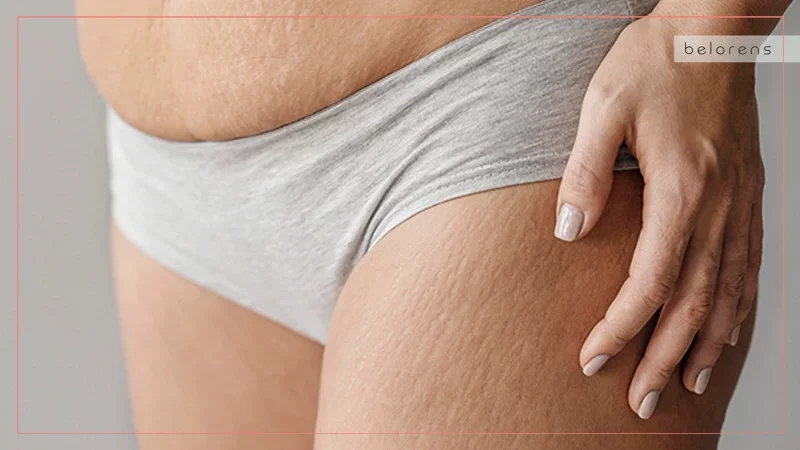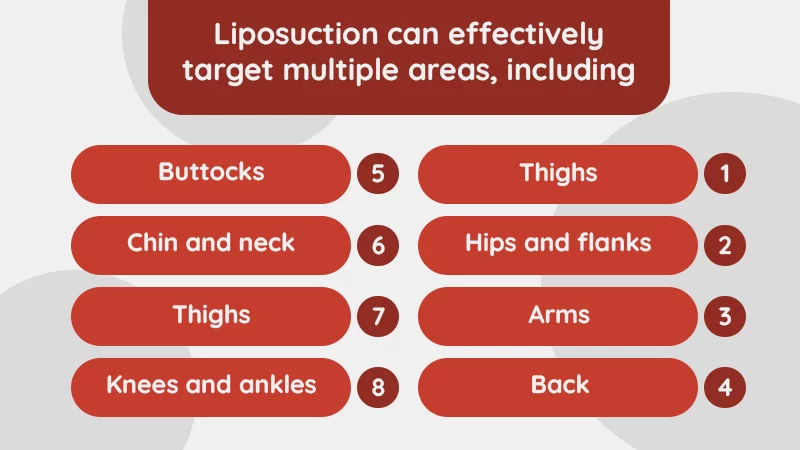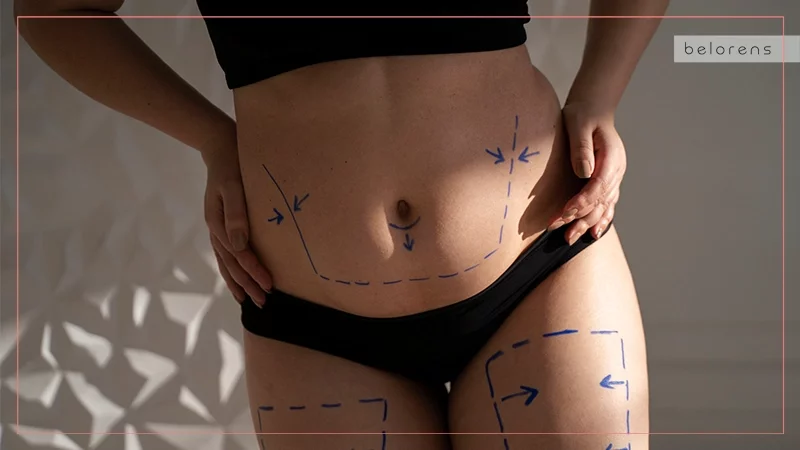Published on 16 Oct 2024
11 Common Liposuction Myths Debunked
- ByMedical Content Team
- Medically Reviewed byDr. Sabine Kulhanek
Fact checked

- Myth 1: Liposuction is a weight loss solution
- Myth 2: Liposuction is only for women
- Myth 3: Liposuction can treat cellulite
- Myth 4: The fat will come back after liposuction
- Myth 5: Liposuction results are permanent
- Myth 6: Liposuction is only for the abdominal area
- Myth 7: Liposuction results are immediate
- Myth 8: Liposuction leaves significant scars
- Myth 9: Liposuction is extremely painful
- Myth 10: Liposuction is only for young people
- Myth 11: Liposuction tightens the skin
Liposuction, a popular cosmetic procedure designed to remove stubborn fat deposits, has helped countless individuals achieve their desired body contours. However, despite its widespread acceptance and success, numerous myths and misconceptions still surround this transformative surgery. These myths often lead to confusion, unrealistic expectations, and unwarranted fears for those considering the procedure. In this blog post, we aim to debunk some of the most common liposuction myths, providing you with accurate information and a clearer understanding of what liposuction can and cannot do. Whether you're contemplating liposuction or simply curious about the facts, read on to separate the myths from the reality and make informed decisions about your body and health.
Myth 1: Liposuction is a weight loss solution
One of the most prevalent myths about liposuction is that it helps you lose weight. This misconception can lead to unrealistic expectations and disappointment for those considering the procedure. In reality, liposuction is designed to remove localized fat deposits that are resistant to diet and exercise, rather than to significantly reduce overall body weight.
Liposuction is best suited for individuals who are already close to their ideal weight but struggle with specific areas of fat that seem impossible to lose. Common target areas include the abdomen, thighs, hips, and arms. The procedure enhances body contours and proportions, providing a more sculpted appearance rather than causing substantial weight loss.
It is important to understand that liposuction is not a substitute for healthy lifestyle choices. Maintaining a balanced diet after liposuction and a regular exercise regimen is crucial for overall health and for preserving the results of the procedure. In summary, while liposuction can refine your body's shape, it should not be viewed as a primary method for losing weight.
Myth 2: Liposuction is only for women
A common misconception is that liposuction is a procedure exclusively for women. This myth can discourage men from considering liposuction as a viable option for addressing their own body contouring needs. In reality, liposuction is suitable for both men and women who wish to remove stubborn fat deposits and achieve a more defined physique.
Men often seek liposuction for areas such as the abdomen, flanks (love handles), chest, and chin. The goals may vary, but the procedure is equally effective for enhancing the contours and proportions of the male body. Men, like women, can experience pockets of fat that are resistant to diet and exercise, and liposuction offers a solution to these problem areas.
In recent years, the number of men opting for cosmetic procedures, including liposuction, has increased significantly. This trend reflects a growing recognition that body contouring is not gender-specific and that everyone deserves to feel confident in their appearance. Accordingly, liposuction is a versatile procedure suitable for anyone looking to improve their body contours, regardless of gender.
Myth 3: Liposuction can treat cellulite

Another widespread myth about liposuction is that it can effectively treat cellulite. This belief often leads to misconceptions about what the procedure can achieve, resulting in unrealistic expectations. However, it’s important to clarify that liposuction is not designed to address cellulite.
Cellulite is caused by the fibrous connective tissues that pull down on the skin, creating a dimpled or lumpy appearance, typically on the thighs, buttocks, and hips. Liposuction targets deeper layers of fat and is effective in removing localized fat deposits to contour and shape the body. However, it does not affect the superficial layer of fat and connective tissue that causes cellulite.
For those looking to reduce the appearance of cellulite, other treatments are more appropriate. These may include Cellfina, Cellulaze, radiofrequency, and other non-invasive procedures that specifically target the structure of cellulite. These methods can help improve the skin's texture and reduce the dimpled appearance.
Myth 4: The fat will come back after liposuction
While it is true that maintaining results requires a commitment to a healthy lifestyle, the notion that the fat will simply return after liposuction is not accurate.
Liposuction permanently removes fat cells from targeted areas of the body. Once these fat cells are removed, they do not regenerate. This means that the specific areas treated with liposuction will have fewer fat cells and will be less likely to accumulate fat in the same way as before. However, the remaining fat cells in the body can still expand if there is significant weight gain.
To maintain the results of liposuction, it is crucial to follow a healthy lifestyle, including a balanced diet and regular exercise. If a person gains a moderate amount of weight after the procedure, the fat may be distributed more evenly across the body rather than accumulating in the treated areas. On the other hand, significant weight gain can cause the remaining fat cells to enlarge, which can diminish the results of the procedure.
In conclusion, while liposuction permanently removes fat cells from specific areas, it is up to the individual to maintain their new shape through healthy living. The fat will not return to the treated areas if a stable weight is maintained, but significant weight gain can affect overall body fat distribution.
Myth 5: Liposuction results are permanent

In contrast to the previous misconception, some people say that the results of liposuction are permanent. While it's true that liposuction removes fat cells from targeted areas, it's important to understand that this does not make the results immune to future changes.
Liposuction effectively removes fat cells from specific areas of the body, and once these cells are removed, they do not regenerate. This means that the contours created by liposuction can be long-lasting. However, the remaining fat cells in the body can still expand if you gain weight after the procedure.
Maintaining a stable weight through a balanced diet and regular exercise is crucial to preserving the results of liposuction. Significant weight gain can cause fat cells in untreated areas to expand and potentially lead to new fat deposits in different parts of the body.
Additionally, the natural aging process can affect your body's shape and skin elasticity over time, which might alter the appearance of the treated areas. Therefore, while liposuction can provide long-lasting results, it is not a guarantee of a permanently fixed body contour without the commitment to a healthy lifestyle.
In summary, liposuction can significantly enhance your body’s shape and contours by permanently removing fat cells from targeted areas. However, maintaining these results requires a commitment to healthy living and weight management. Understanding this can help you set realistic expectations and make informed decisions about the procedure.
Myth 6: Liposuction is only for the abdominal area

A prevalent misconception is that liposuction is solely intended for the abdominal area. While the abdomen is indeed a popular target for liposuction, this versatile procedure can be used to remove unwanted fat from various parts of the body.
Liposuction can effectively target multiple areas, including:
- Thighs: Both inner and outer thighs can be contoured to reduce bulkiness and improve leg shape.
- Hips and flanks: Commonly known as "love handles," these areas can be slimmed down for a more streamlined silhouette.
- Arms: Upper arms, particularly the area prone to "bat wings," can be sculpted to achieve a more toned appearance.
- Back: Liposuction can address fat deposits in the upper and lower back, creating a smoother contour.
- Buttocks: Excess fat can be removed or redistributed to enhance the shape and lift of the buttocks.
- Chin and neck: Submental liposuction targets the area under the chin and neck to reduce the appearance of a double chin and improve jawline definition.
- Chest: In men, liposuction can be used to treat gynecomastia (enlarged male breasts) for a more masculine chest contour.
- Knees and ankles: Liposuction can also be used to refine and contour areas around the knees and ankles.
Also Read: Understanding the Distinction between CoolSculpting and Liposuction
Myth 7: Liposuction results are immediate
Many people believe that the results of liposuction are immediate, expecting to see their desired body shape as soon as the procedure is completed. However, this is a common myth that can lead to misunderstanding and unrealistic expectations.
In reality, the results of liposuction take time to become fully apparent. After the procedure, it is normal to experience swelling and bruising in the treated areas. This initial swelling can obscure the final results, making it difficult to see the full effect of the fat removal right away. The body needs time to heal and adjust after liposuction. The swelling gradually decreases over several weeks to months, allowing the new contours to become more visible.
It typically takes about three to six months for the swelling to completely subside and for the final results to be fully evident. During this period, the skin will also retract and tighten around the new contours. Proper post-operative care, including wearing compression garments and following your surgeon’s instructions, is crucial for optimizing the healing process and achieving the best possible results.
Understanding that liposuction results are not immediate helps set realistic expectations for the recovery period. Patience and adherence to post-operative care are essential for ensuring the best possible outcome from the procedure.
Myth 8: Liposuction leaves significant scars
One of the common fears people have about liposuction is the fear of scars. Many potential patients worry that the procedure will leave significant, visible scarring. However, modern liposuction techniques have advanced significantly to minimize this concern.
Liposuction is performed using small, strategically placed incisions that allow the surgeon to insert a thin tube called a cannula to remove excess fat. These incisions are typically very small, often just a few millimeters in length, and are carefully placed in discreet areas to minimize visible scarring.
Advancements in surgical techniques and tools have further reduced the size of these incisions, making them less noticeable. Surgeons often place the incisions in natural creases or folds of the skin, where any resulting scars can be easily concealed.
Moreover, proper post-operative care is crucial in ensuring that any scarring is minimal. Following the surgeon's instructions, using prescribed topical treatments, and protecting the incision sites from sun exposure can significantly improve the appearance of scars over time.
While it is true that any surgical procedure will leave some degree of scarring, the scars from liposuction are generally small and fade considerably with time. Many patients find that the benefits of the procedure far outweigh the minor and often barely visible scars that result.
Also Read: How Are Liposuction and Tummy Tuck Different?
Myth 9: Liposuction is extremely painful

A pervasive myth about liposuction is that it is an extremely painful procedure, which can cause undue fear and deter individuals from considering this body contouring option. However, advancements in medical technology and pain management have significantly improved the comfort of patients undergoing liposuction.
During the procedure, patients are typically given anesthesia—either local, regional, or general—depending on the extent of the liposuction and the patient’s specific needs. This ensures that the procedure itself is painless. Local anesthesia is often combined with sedation to help patients remain comfortable and relaxed.
Post-operative discomfort is generally manageable and can vary depending on the individual and the extent of the procedure. Most patients describe the post-operative sensation as similar to muscle soreness or bruising rather than severe pain. This discomfort usually peaks within the first few days after surgery and gradually subsides over the following weeks.
Pain management strategies, including prescribed medications and proper post-operative care, play a crucial role in ensuring a smooth recovery. Following the surgeon’s instructions, such as wearing compression garments and avoiding strenuous activities, can help minimize discomfort and promote healing.
It's also worth noting that each person's pain tolerance is different, and while some may experience more discomfort than others, the overall consensus is that liposuction is not "extremely" painful. The advancements in surgical techniques and post-operative care have made the experience more comfortable than ever before.
Myth 10: Liposuction is only for young people
A common misconception is that liposuction is only suitable for young people. This myth can discourage older individuals from considering the procedure, despite the fact that age is not a primary factor in determining candidacy for liposuction.
Liposuction can be performed on individuals of various ages, as long as they are in good health and have realistic expectations about the results. The key factors that determine eligibility for liposuction include skin elasticity, overall health, and the presence of stubborn fat deposits that do not respond to diet and exercise.
As people age, their skin loses some of its elasticity. However, many older adults still possess enough skin elasticity to achieve satisfactory results from liposuction. In cases where skin elasticity is significantly reduced, combining liposuction with other procedures, such as a tummy tuck or a body lift, can help achieve better overall results by addressing both fat removal and skin tightening.
Good overall health is crucial for any surgical procedure, regardless of age. Prospective patients should undergo a thorough medical evaluation to ensure they do not have any underlying health conditions that could complicate surgery or recovery. Conditions such as heart disease, diabetes, or issues with blood clotting can affect candidacy for liposuction.
It's important for older patients to have realistic expectations and understand that while liposuction can enhance their body contours, it does not stop the natural aging process. Maintaining a healthy lifestyle post-procedure is essential for preserving the results.
In conclusion, liposuction is not exclusively for young people. Adults of various ages can benefit from this procedure, provided they have good skin elasticity, are in overall good health, and have realistic expectations about the outcomes. By dispelling this myth, we hope to encourage more people to explore their options and make informed decisions about their body contouring goals, regardless of their age.
Also Read: 7 Myths about Weight Loss Surgeries
Myth 11: Liposuction tightens the skin
This misconception can lead to unrealistic expectations about the procedure's outcomes. In reality, liposuction primarily targets and removes excess fat deposits; it does not inherently tighten the skin.
Liposuction works by suctioning out fat cells from specific areas of the body through small incisions. While this can significantly improve body contours and reduce unwanted fat, the procedure does not address skin elasticity. The ability of the skin to retract and conform to the new body contours depends largely on its pre-existing elasticity and the individual’s age, genetics, and skin quality.
For individuals with good skin elasticity, the skin may naturally retract to some extent after fat removal, leading to satisfactory results. However, for those with loose or sagging skin, such as older adults or individuals who have experienced significant weight loss, the skin may not tighten sufficiently on its own after liposuction. In these cases, additional procedures, such as a tummy tuck, arm lift, or thigh lift, might be necessary to remove excess skin and achieve a firmer, smoother appearance.
Patients must have a thorough consultation with their surgeon to discuss their skin condition and the realistic outcomes of liposuction. Surgeons can provide personalized recommendations and may suggest combining liposuction with skin-tightening procedures to achieve the desired results.
In summary, while liposuction is highly effective for fat removal and body contouring, it does not tighten the skin. The extent of skin retraction after the procedure depends on individual factors such as skin elasticity and overall skin health. For optimal results, especially in cases of significant skin laxity, additional skin-tightening procedures may be recommended. Understanding this distinction helps patients set realistic expectations and make informed decisions about their cosmetic goals.




